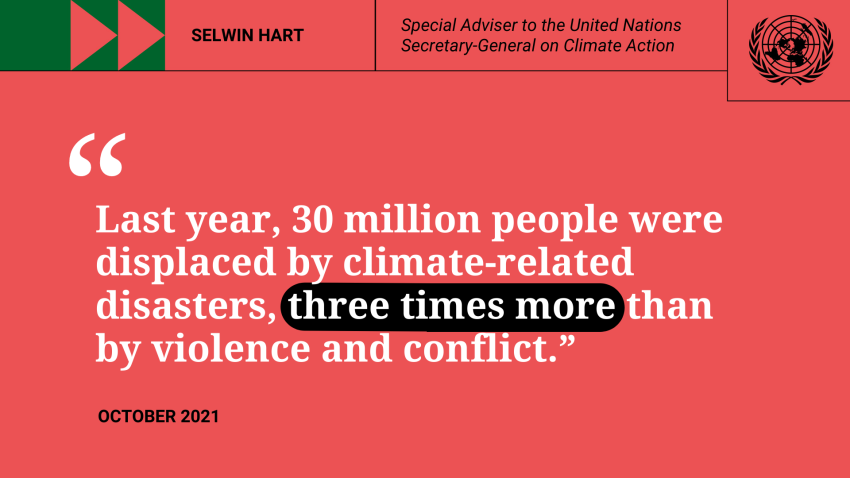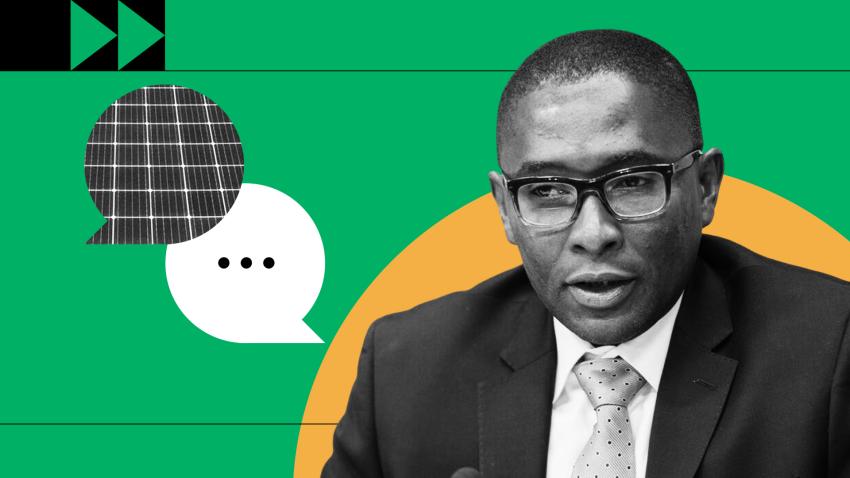As the Special Adviser to the UN Secretary-General on Climate Action, Selwin Hart spearheads a global drive to raise climate ambition now. In this interview, he talks about the critical need for developed countries to finance climate adaptation to save lives and protect livelihoods in countries facing the worst consequences from climate. The interview has been edited for clarity and length.
What’s one thing everyone should know about climate action?
We have a very narrow window of opportunity to prevent the worst impacts of climate change. Climate action is not something that can be delayed for 10, 20 or 30 years. We must take urgent and ambitious action now.
Should we be discouraged by the recent IPCC report?
That report is a wake-up call. If we don’t take actions now to significantly reduce emissions, the world will be on a catastrophic pathway. But the report also provides us with some degree of hope. It tells us that if over the course of the next decade we reduce emissions to half the current levels, we will avoid the worst aspects of climate change.
The good thing is we have the financial tools and technologies to do this. For example, the cost of renewable energy has declined significantly and the share of renewable energy has increased threefold. To limit global warming to no more than 1.5 degrees, we need over the next decade to increase renewable energy by three times yet again. Added benefits come from greater energy security. Rather than relying on volatile energy supplies from abroad, countries can focus on solar and wind to meet growing energy demands.
What does climate adaptation mean?
Adaptation saves and protects lives and livelihoods. It builds the resilience of people, communities and businesses to increasingly more frequent and intense climate impacts. A small island developing State, for example, might build coastal protection against sea level rise and ensure physical infrastructure can withstand stronger storms. A country facing increasing drought needs to invest in early warning systems, prepare farmers and local communities and ensure sufficient reserves of water.
Why do we need to scale up adaptation?
Because climate impacts are getting worse. They are costing lives and causing economic disruption, especially in poor and vulnerable countries. A failure to scale up will mean a massive loss of lives and significant economic disruption. Last year, 30 million people were displaced by climate-related disasters, three times more than by violence and conflict. We have a significant global threat on our hands.

In the Paris Agreement on climate change, developed countries committed to providing public finance to developing countries that was balanced between mitigation and adaptation. Yet adaptation accounts for a mere quarter of total climate finance. That is not balanced, which is why the Secretary-General has been calling on donors and the multilateral development banks to increase the share to at least 50 percent.
Why has adaptation finance lagged?
There are many reasons. The biggest is an absence of political will. If countries are serious about fulfilling this promise, it just takes the stroke of a pen. Three countries have stepped forward so far – Denmark, Netherlands and Sweden. We hope that others will do so as well.
Another concern is red tape to access climate finance, which has to be reduced significantly without compromising the quality and integrity of adaptation and resilience projects. Furthermore, eligibility to access finance is based on per capita income. Many small island developing States and other vulnerable countries are classified by the OECD (Organisation for Economic Co-operation and Development) as middle-income countries. That means they do not have access to grants and concessionary climate finance to invest in resilience building. We see this as shortsighted.
What are the consequences?
In 2019, I had the unfortunate experience of visiting the Bahamas after Hurricane Dorian. It was one of the most searing experiences that I have ever had. It seemed like a bomb had been dropped on an entire island. I’ve never seen devastation like that in my entire life.
I asked at the time, if this country had access to resources to strengthen its infrastructure, regardless of how it is classified by the OECD, would it have made a difference? Would it have saved lives and livelihoods? The international community has to grapple with these questions. It is better to allow countries to access grants and concessionary financing to invest in resilience ahead of disasters than to wait for them to be decimated, at which point the international community has to provide humanitarian assistance. Time is running out to make these choices.
Why is finance for adaptation an issue of justice?
Countries on the frontlines of the climate crisis, like small island developing States, the least developed countries, African countries and other vulnerable countries, have contributed the absolute least to the climate crisis. Yet they face disproportionate impacts. Africa is warming much faster than the global average, for instance, and will see longer periods of drought, famine and extreme flooding.

These frontline countries really need the full support of the international community. There is a clear business imperative for making these investments early. There is also a moral imperative. Quite frankly, after 30 years of multilateral negotiations on climate, and six years after the Paris Agreement, the imbalance in adaptation finance is not acceptable. At Glasgow, we hope a clear message is that no effort will be spared to fulfil the promise made in Paris.
Does there need to be more emphasis on adaptation across economies and societies, going past a focus on separate projects?
We need to enhance planning in developing countries based on a much better understanding of all the challenges they face from a more severe climate. But we need to do that in parallel with making investments in adaptation and resilience given the urgency of the challenge.
Many developing countries in their national climate plans have incorporated planning for adaptation. Many small island developing States have national adaptation and resilience plans in their medium- and long-term development plans. They are planning adaptation that cuts across energy, transportation, agriculture, fisheries and so on. But the challenge remains access to finance. So work on incorporate adaptation across the board must be done but with a level playing field internationally to support these countries.
Who has to move first and most to cut emissions?
The Secretary-General has made a consistent call for leadership by G20 (Group of 20) nations. They account for 80 per cent of global emissions. We are not going to be on a 1.5-degree pathway without their strong leadership. However, all G20 nations are not alike. You cannot have the same expectations of the United States and India. The United States is a very wealthy country and the largest historical emitter. India’s emissions are growing but it is still a developing country with many people in poverty. As it addresses climate change it needs to think about development as well.
What the international community needs to do as a matter of urgency for emerging economies and developing countries is to support cheaper alternatives to meet growing energy demand. Asia and the Pacific has 94 percent of the global coal pipeline. The single most important step to keep the 1.5-degree goal within reach is to rapidly phase out coal. This region needs to be supported to move to a clean energy pathway. As I said earlier, the technologies are there.
Emerging economies, as the Secretary-General has said, must make an extra effort. Part of the compact of the Paris Agreement is that they are to be provided with some support if needed. But the expectation remains that there will be leadership from the developed world, recognizing of course that we all share in the global effort to keep 1.5 degrees alive.

Climate change is not an easy set of issues. What keeps you going?
I started out as a climate negotiator for Barbados and then for the Caribbean and the Alliance of Small Island Developing States. One thing I recognized quite early was that the role of the small island developing States is really to raise the global alarm that climate change is not only real but will impact everyone. These countries are really the conscience of the multilateral process.
It was daunting for us to put some of the most ambitious proposals on the table, which at the outset were rejected. In 2009, when we first called for the 1.5-degree goal, only the least developed countries supported us. Back then, the major economies like the European Union and the United States were focused on 2 degrees, but we knew that 2 degrees would see some of our members disappear from the face of this earth. I remember one very difficult meeting where we concluded that it was better to walk away from the table than to accept the 2-degree goal.
Things have changed; 1.5 degrees has become the global goal. But a lot has not changed. The small island developing States still face an uncertain future.
For me, climate is personal. I have colleagues and friends who still live on these islands. We’ve fought side by side to defend the interests of our people. And we cannot let them down. There have been moments when it felt as though we should give up, but then we are constantly reminded of what we are fighting for and who we are fighting for. Quite frankly, this is what continues to inspire and motivate me. It is not about me, but it’s about those folks who will never enter one of those meeting rooms, will never participate in climate talks, but whose future is being determined by the actions of others.
We cannot give up on this fight. It will be daunting. There will be setbacks. But we have to continue.
What do you hope from COP26?
Glasgow really needs to keep 1.5 within reach in a very credible way. We know that national commitments so far will not add up. But we cannot close the window on 1.5.
On adaptation and resilience, developed countries need to step up and support the call for 50 percent. Glasgow has to be that moment where the world starts to take adaptation and resilience seriously. I’ve seen repeatedly where vulnerable countries are trotted out as symbols of climate vulnerability. But words or expressions of solidarity are absolutely meaningless if they are not backed up by very concrete actions.
A final note is we need to continue to find ways to involve young people in discussions and decisions on climate change. I hear their frustration. They are right. It has taken us too long to act and now the burden falls on their shoulders. I’m hoping that we hear the voices of young people at Glasgow and post-Glasgow. More than that, we must ensure that they have a seat at the table when important decisions are taken on their future.



